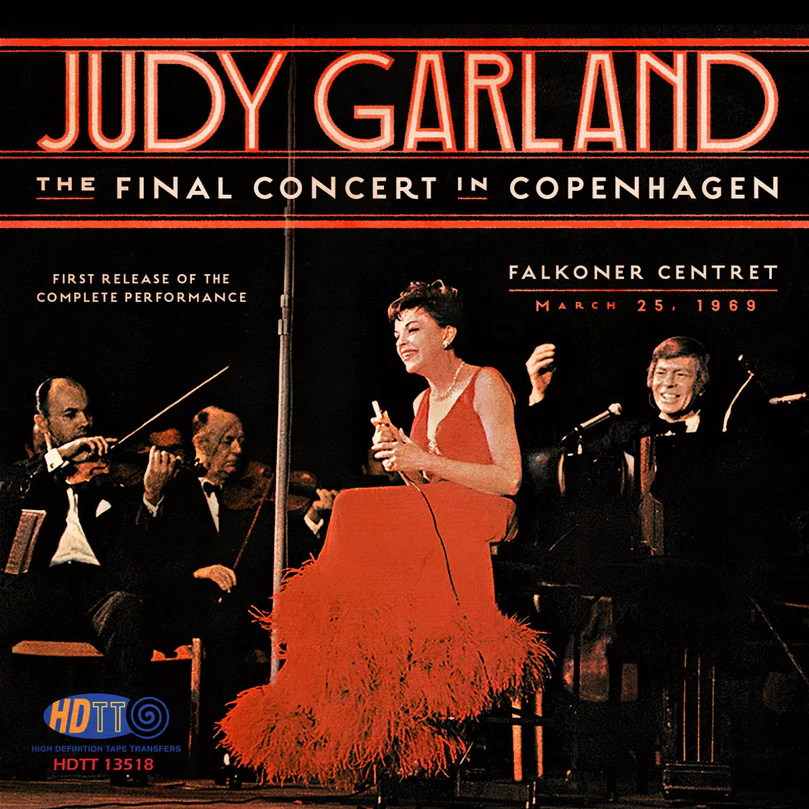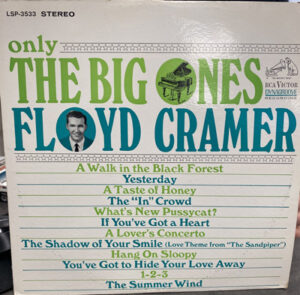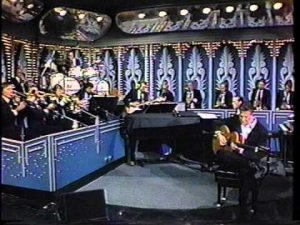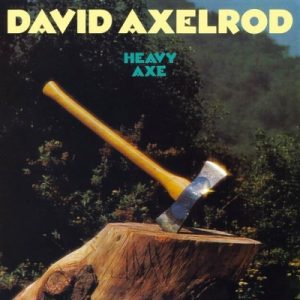Some recordings are highlights of our music culture and are loved by generations. Judy Garland at Carnegie Hall, 1961, is such a recording. It is a remarkable tribute to a great artist performing at the top of her game. And, in this newly restored and remastered release from HDTT, it sounds better than it ever has sounded.
Judy Garland, The Greatest Night In Show Business History, Carnegie Hall, 1961. HDTT 2022 (DSD256, DXD) HERE
This recording has received multiple reissues, including a few that have attempted to give us the live natural sound that the audience experienced at the actual event (viz., Steve Hoffman's remastering for DCC Compact Classics on CD in 2000). But this new restoration by Bob Witrak and John Haley have finally brought this marvelous live recording fully to life in this superb new remastering.
Like the DCC reissue, this release eschews excess artificial reverb to give us a very natural sounding hall acoustic. It keeps Judy Garland's voice front and center, with beautiful tone and fullness. Audience applause is present, but intrusive audience noise is absent. The backing orchestra and percussion are alive with great impact and frequency extension. Most importantly, the entire performance is ON PITCH and completely stable—not a bit of pitch instability that I could hear.
Just queue up "Puttin' on the Ritz," track 8, to hear what I'm talking about in less than 2 minutes. And for a treat, allow the music to roll into the next track, "How Long Has This Been Going On." In two cuts, you'll hear why she was so special.
In the DSD256 version to which I am listening, the concert sounds as present and alive as if I've been given a seat in the audience. It is simply terrific. And terrifically moving to hear the great Judy Garland sounding like the superb performer she was. If you've not grown up knowing Judy Garland and want to hear why she was so beloved, get this recording. If you already love Judy Garland, then this is (finally) the great release of this recording that Judy has always deserved.
Just before "Over the rainbow," in response to the audience's applause and call-outs for other well-known songs. Judy Garland says, "I know. I'll sing 'em all and stay all night." Yes, let me stay all night, too. What a marvelous experience to hear her in such outstanding sound quality as HDTT has given us! Many thanks.
You're welcome to simply stop reading here and just go get this new release. You will not be disappointed.
(Update: Added August 16, 2022) Perhaps the most meaningful confirmation of the results John and Bob have accomplished in this restoration is this comment from a verified purchaser of the album, William R. Lyon, that he posted to the HDTT website:
The Best Recording Ever of The Best Night Ever.
I'll preface this little review by saying I am 85 years old and was privileged to have attended this concert at CH. I had an aisle seat given to me by my theatrical agent, Sara Enright. She had purchased a small block of seats as gifts for her clients. No one will remember my brief show biz career, but you might recall the gentleman sitting right in front of me, Henry Fonda. What a night! What a record! This is the closest any recording has come to the sound of Judy's voice. I think I have owned every edition from every label and this one nails her sound and her gigantic need for the audience to love her. I was 24 years old in 1961 and her voice brought me to tears many times that night. Fonda cried too… when he wasn’t jumping up at the end of every number to applaud and produce the loudest whistles I had ever heard. (Carnegie Hall) was awash with celebrities, stars, the rich, and the famous; they would have gladly stayed all night under the magic spell that Garland created. Listen closely to the voice, the vibrato, the sighs, the trembling of her hand on the mike; it’s all there on this new recording and if you listen with both ears and your heart, you can hear the MAGIC.
Now, this is quite a testament!
If you're interested in how John and Bob accomplished this restoration, read on...
The following Technical Notes were written by John Haley and are included in the downloadable booklet accompanying the album HERE. With John's permission, I am reproducing his article below because he describes in such excellent detail the work that went into this impeccable restoration.
Judy Garland: The Greatest Night in Show Business History, Carnegie Hall, April 23, 1961 in High-Definition Audio. Technical Notes by John H. Haley:
This is the first high-definition release of a famous recording of a famous concert, in a brand new restoration prepared for release in DSD256 format and other digital download formats, and also available on regular CD.
Judy Garland’s live concert at Carnegie Hall on April 23, 1961 was by all accounts a pinnacle in her career as a concert artist. The great Capitol LP recording of that event, which won five Grammy Awards, including Album of the Year and Best Female Vocal Performance, remained on the Billboard charts for 73 weeks, including 13 weeks at the number one spot. This iconic recording has likewise become a touchstone for quality among Garland’s many outstanding commercial recordings.
In the six decades since its release, as audio formats came and went, this recording was remastered a number of times in various ways to present different "slants" on it, but this new restoration and remastering, released to celebrate Garland’s centennial, sets a new standard. The initial transfer was made by HDTT engineer Robert Witrak at the highest sampling rate in use today, DSD256, using HDTT's proprietary methods and superior equipment. It was then meticulously restored and remastered in DXD PCM 352.8 kHz, 24/32 bit, which is the best format for post-processing DSD-originated digital recordings, by John H. Haley of Harmony Restorations LLC.
The goal has been to present as realistic a sonic image as possible of Garland appearing live on the stage of Carnegie Hall, performing in front of the brilliant accompanying forty-piece orchestra led by Mort Lindsey. This endeavor includes precisely correct pitching (the original release and many subsequent ones were slightly sharp), as well as respect for the unique acoustic of Carnegie Hall, universally recognized as a crown jewel of the world's concert venues. Abetted by the far greater level of detail permitted by the high-definition format, this new release strives to put listeners in a prime seat in Carnegie Hall.
As we know from prior accounts, this recording was originally made in three channels, with the orchestra occupying the left and right channels in a normal stereo spread, and Garland recorded in the center channel, said to be captured "dry" (without reverb, natural or otherwise). Garland was of course using a hand-held mic that was feeding the Carnegie Hall PA system, which would have dispersed her voice throughout the hall, and we can speculate with some level of certainty that this same mic feed would have been used for the center channel of the recording.
Much has been made of the generous reverberation heard in some versions of this recording. If in fact Garland's voice was recorded "dry," then some amount of artificial reverb was certainly added to her vocals before they were mixed into the left and right channels to create the two-channel stereo version heard on most stereo releases (no three-channel version has ever been released). Reverb has of course been routinely added to enhance pop vocal recordings since external reverb became a possibility, and Garland’s commercial recordings are no exception, starting at least in the 1950's. As revealed by the greater level of detail present in HDTT's high-definition capture, the sound of the orchestra does possess a realistic presentation of the sound of Carnegie Hall, well known for both its clarity and its fulsome and rather long natural hall reverb. If artificial reverb was added to the orchestral channels to mimic the sound of Carnegie Hall (which seems doubtful), it was quite skillfully done. We believe it is likely that the hall reverb heard on the orchestral playing is entirely or at least mostly genuine, helping to create a brilliant, full-bodied yet detailed sound.
Regarding the reverb heard on the vocals, which is much less likely to be natural hall reverb, and again as heard in HDTT’s detailed hi-def capture, we were struck by the extent to which the original mixers succeeded in matching the sound of Garland's voice to the reverb heard in the orchestra channels. It seems obvious that their intent was the same as ours, to present a sonic picture of Garland on the stage of Carnegie Hall in front of the orchestra, appearing together in the same sonic "envelope." But this process was nevertheless imperfect back in 1961, resulting in what many would agree is a touch of excessive vocal reverb, worse in certain spots. We have addressed this issue both overall with a light touch and with more attention given to those particular excessive spots, in an effort to keep her matching the sound of the orchestra as much as possible.
It is surprising to us how many of the past restorations of this concert have abandoned all effort to preserve the sound of Carnegie Hall or present any kind of realistic image of an actual concert taking place there, instead treating this recording more like some kind of studio recording. While we do not doubt the good intentions behind prior efforts, there seem to have been many other operative priorities in how the sound was treated.
We have also addressed any number of smaller issues, such as annoying loud low frequency thumps coming from aspirations by Garland into her mic (which we have removed) and some obvious tape splicing errors. One in particular stands out—in the opening line of her well-known theme song "Over the Rainbow," on the second syllable of the word "rainbow," Garland appears to have croaked, with an odd warble such as we do not hear from her elsewhere, in a song that she had performed hundreds of times. Close examination of this trouble spot on the waveform, on the computer screen, shows that two crude tape splices occur in this spot, a few seconds apart, so the croaking sound is clearly not anything that came out of Garland's mouth at the concert. It is hard to imagine the reason for such a crude "correction"—damage to the master tape in this spot seems like a good guess. We just repaired this spot. As another example, in another spot a bad splice resulted in a double entrance by Garland, which surely did not actually occur.
We hope that this new hi-def release will bring listeners closer than ever before to "being there" at one of the most exciting live concerts ever recorded.
Reproduced with permission of the author, John Haley, CEO, Harmony Restorations, LLC
I can't imagine the hours of work John invested in his painstaking restoration of this recording. Lawrence Schulman, producer and music critic, writes the liner notes for this release. In those liner notes he shares that in a 2014 interview, John Haley stated: "I have to agree with my friend Jon Samuels, an audio restoration guru for many years, that the first rule of audio restoration is the same Hippocratic oath that doctors take: ‘Do no harm.’ It’s really all about the music, not about the egos of the people who step in between the performing artist and his or her ultimate audience. The goal for a restoration person is to be invisible. If I have done a good job on something, a listener should be unaware of my work."
John's work is indeed invisible—it is a consummate restoration that gives outstanding life to this wonderful concert. In this release, it is decidedly "The Greatest Night in Show Business History."
ADDENDUM
To this article, it seems fitting to mention yet another restoration of a treasured Judy Garland live performance. Also from HDTT, and due to the excellent restoration efforts by John Haley, is a release for the first time of Judy Garland's complete final 1969 concert in Copenhagen. See my review from a few weeks ago HERE.
Judy Garland The Final Concert In Copenhagen, 1969. HDTT 2022 (DXD) HERE
Update: Leon Nock has written a nice "Centennial Appreciation" for the life and work of Judy Garland. It appears in High Definition Tape Transfer's Blog, and you can enjoy reading it here.











































